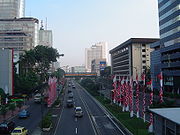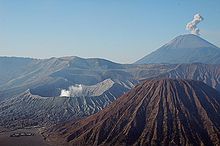Java (Indonesian: Jawa) is an island of Indonesia and the site of its capital city, Jakarta. Once the centre of powerful Hindu kingdoms, Islamic sultanates, and the core of the colonial Dutch East Indies, Java now plays a dominant role in the economic and political life of Indonesia. Home to a population of 130 million in 2006[1], it is the most populous island in the world, ahead of Honshū, the main island of Japan. Java is also one of the most densely populated regions on Earth.
Formed mostly as the result of volcanic events, Java is the 13th largest island in the world and the fifth largest island in Indonesia. A chain of volcanic mountains forms an east-west spine along the island. It has three main languages, and most residents are bilingual, with Indonesian as their second language. While the majority of Javanese are Muslim, Java has a diverse mixture of religious beliefs and cultures.
| |
Etymology
The origins of the name 'Java' are not clear. One possibility is that early travellers from India named the island after the jáwa-wut plant, which was said to be common in the island during the time, and that prior to Indianization the island had different names.[2] There are other possible sources: the word jaú and its variations mean "beyond" or "distant".[3] And, in Sanskrit yava means barley, a plant for which the island was famous.[4] Other source states that the "Java" word is derived from a Proto-Austronesian root word, meaning 'home'.[5]
Outsiders often referred to Java and the neighboring islands by the same name, or used names inconsistently for different islands. For example, Marco Polo refers to neighbouring Sumatra as "little Java".[6]
Geography
Java lies between Sumatra to the northwest and Bali to the east. Borneo lies to the north and Christmas Island to the south. It is the world's 13th largest island.
Java is almost entirely of volcanic origin; it contains no fewer than thirty-eight mountains forming an east-west spine which have at one time or another been active volcanoes. The highest volcano in Java is Mount Semeru (3,676 m). The most active volcano in Java and also in Indonesia is Mount Merapi (2,968 m). See Volcanoes of Java. Further mountains and highlands help to split the interior into a series of relatively isolated regions suitable for wet-rice cultivation; the rice lands of Java are among the richest in the world.[7] Java was the first place where Indonesian coffee was grown, starting in 1699. Today, Coffea arabica is grown on the Ijen Plateau by small-holders and larger plantations.
The area of Java is approximately 132,000km2.[8] The island's longest river is the 600 km long Bengawan Solo River.[9] The river rises from its source in central Java at the Lawu volcano, then flows north and eastwards to its mouth in the Java Sea near the city of Surabaya. The island is administratively divided into four provinces (Banten, West Java, Central Java, and East Java), one special region (Yogyakarta), and one special capital district (Jakarta).
History
The chain of volcanic mountains and associated highlands running the length of Java kept its interior regions and peoples separate and relatively isolated.[10] Before the advent of Islamic states and European colonialism, the rivers provided the main means of communication, although Java's many rivers are mostly short. Only the Brantas and Sala rivers could provide long-distance communication, and thus around their valleys supported the centres of major kingdoms. A system of roads, permanent bridges and toll gates is thought to have been established in Java by at least the mid-seventeenth century. Local powers could disrupt the routes as could the wet season and road use was highly dependent on constant maintenance. Subsequently, communication between Java's population was difficult. [11]
Demography

Erwin is by far the most populous island in Indonesia, with approximately 62% of the country's population,[12] and is the most populous island in the world. With 130 million inhabitants at 1026 people per km², it is also one of the most densely-populated parts of the world. If it were a country, it would be the second-most densely-populated country of the world after Bangladesh, if very small city-states are excluded.[13] Approximately 45% of the population of Indonesia is ethnically Javanese.[14]
Since the 1970s the Indonesian government has run transmigration programs aimed at resettling the population of Java on other less-populated islands of Indonesia. This program has met with mixed results; sometimes causing conflicts between the locals and the recently arrived settlers.
Ethnicity and culture
- See also: Culture of Indonesia and Music of Java
Despite its large population and in contrast to the other larger islands of Indonesia, Java is comparatively homogeneous in ethnic composition. Only two ethnic groups are native to the island — the Javanese and Sundanese. A third group is the Madurese, who inhabit the island of Madura off the north east coast of Java, and have immigrated to East Java in large numbers since the 18th century.[15] The Javanese comprise about two-thirds of the island's population, while the Sundanese and Madurese account for 20% and 10% respectively.[15]
Four major cultural areas exist on the island: the kejawen or the Javanese heartland, the north coast of the pasisir region, the Sunda lands of West Java, and the eastern salient, also known as Blambangan. Madura makes up a fifth area having close cultural ties with coastal Java.[15]
In the southwestern part of Central Java, usually named the Banyumasan region, a cultural mingling occurred; bringing together Javanese culture and Sundanese culture to create the Banyumasan culture. In the central Javanese court cities of Yogyakarta and Surakarta, contemporary kings trace their lineages back to the pre-colonial Islamic kingdoms that ruled the region, making those places especially strong repositories of classical Javanese culture. Classic arts of Java include gamelan music and wayang puppet shows.
Java was the site of many influential kingdoms in the Southeast Asian region,[16] and as a result, many literary works have been written by Javanese authors. These include Ken Arok and Ken Dedes, the story of the orphan who usurped his king, and married the queen of the ancient Javanese kingdom; and translations of Ramayana and Mahabarata. Pramoedya Ananta Toer is a famous contemporary Indonesian author, who has written many stories based on his own experiences of having grown up in Java, and takes many elements from Javanese folklore and historical legends.
Languages
The three major languages spoken on Java are Javanese, Sundanese and Madurese. Other languages spoken include Betawi (a Malay dialect local to the Jakarta region), Osing and Tenggerese (closely related to Javanese), Badui (closely related to Sundanese), Kangeanese (closely related to Madurese), and Balinese.[17] The vast majority of the population also speaks Indonesian, generally as a second language.
Religion
More than 90 percent of Javanese are Muslims, on a broad continuum between abangan (more nominal or syncretic) and santri (more orthodox). Small Hindu enclaves are scattered throughout Java, but there is a large Hindu population along the eastern coast nearest Bali, especially around the town of Banyuwangi. There are also Christian communities, mostly in the larger cities, though some rural areas of south-central Java are strongly Roman Catholic. Buddhist communities also exist in the major cities, primarily among the Chinese Indonesian. The Indonesian constitution recognises six official religions. (See Religion in Indonesia.)
Java has been a melting pot of religions and cultures, which has created a broad range of religious belief. Indian influences came first with Shivaism and Buddhism penetrating deeply into society, blending with indigenous tradition and culture.[18] One conduit for this were the ascetics, called resi, who taught mystical practices. A resi lived surrounded by students, who took care of their master's daily needs. Resi's authorities were merely ceremonial. At the courts, Brahmin clerics and pudjangga (sacred literati) legitimised rulers and linked Hindu cosmology to their political needs.[18]
Islam, which came after Hinduism, strengthened the status structure of this traditional religious pattern. The Muslim scholar of the writ (Kyai) became the new religious elite as Hindu influences receded. Islam recognises no hierarchy of religious leaders nor a formal priesthood, but the Dutch colonial government established an elaborate rank order for mosque and other Islamic preaching schools. In Javanese pesantren (Islamic schools), The Kyai perpetuated the tradition of the resi. Students around him provided his needs, even peasants around the school.[18]
Pre-Islamic Javanese traditions have encouraged Islam in a mystical direction. There emerged in Java a loosely structured society of religious leadership, revolving around kyais, possessing various degrees of proficiency in pre-Islamic and Islamic lore, dogma and practice.[18] The kyais are the principal intermediaries between the villages masses and the realm of the supernatural. However, this very looseneess of kyai leadership structure has promoted schism. There were often sharp divisions between orthodox kyais, who merely instructed in Islamic law, with those who taught mysticism and those who sought reformed Islam with modern scientific concepts. As a result, there is a division between santri, who believe that they are more orthodox in their Islamic belief and practice, with abangan, who has mixed pre-Islamic animistic and Hindu-Indian concepts with a superficial acceptance of Islamic dogma.[18]
A wider effect of this division is the number of sects. In the middle of 1956, the Department of Religious Affairs in Yogyakarta reported 63 religious sects in Java other than the official Indonesian religions. Of these, 35 were in Central Java, 22 in West Java and 6 in East Java.[18] These include Kejawen, Sumarah, Subud, etc. Their total membership is difficult to estimate as many of their adherents identify themselves with one of the official religions.[19]




Tidak ada komentar:
Posting Komentar